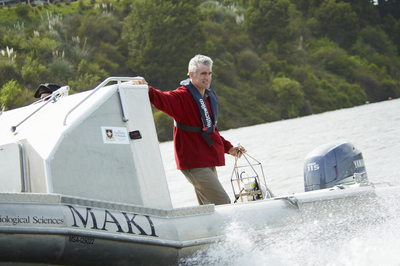Getting on top of the toxins
University of Waikato ecologist Professor David Hamilton has been awarded a $920,000 Marsden Grant to study toxin production found in blue-green algae in lakes. His research project is titled ‘Toxic in crowds: the triggers of toxin production in planktonic cyanobacteria’.
Cyanobacteria are commonly called blue-green algae and some species can produce potent toxins which affect humans through drinking water or contact recreation, as well as other organisms that live in the water. Blue-green algae are stimulated to grow and form blooms by increasing levels of nutrients.

Recent records of increases in nutrient loads to lakes are therefore of particular concern, both from an environmental point of view and for human health considerations. Professor Hamilton and his colleagues, including Dr Susie Wood from Cawthron in Nelson, have found that when blue-green algae congregate into dense blooms they can rapidly ramp up the rate of toxin production.
“This project will try to understand why blue-green algae produce toxins and what specific triggers make the blue-green algae increase toxin production when they form blooms,” said Hamilton.
Professor Hamilton is one of six Waikato academics who received Marsden Grants totalling $3.6 million in the latest round of funding, which is administered by the Royal Society of New Zealand on behalf of the Marsden Fund Council and funded by the New Zealand Government.
He has been researching aspects of water quality for more than 20 years and is currently part of a team that is trialling an aeration device on Lake Rotoehu, pumping oxygen into the water to counteract the harm done by nutrients and sediment that have leached or run off into the lake.
“Blooms of blue-green algae are increasing across the globe and scientists are trying to understand why. One culprit may be intensification of agricultural land, leading to more nutrients to fuel blooms of blue-green algae. Another may be climate change, since many lakes across the globe have warmed by 1 to 2°C over the past two decades; even more rapidly than increases in air temperature,” said Hamilton.
Blue-green algae are favoured by higher temperatures because they originate from bacteria which grow more rapidly than other algae at elevated temperatures. The Marsden funding will help to identify both the causes of blue-green algal blooms and the relationship of blooms to toxin production.
Hamilton said: “Ultimately it is hoped that the outcomes of the project will improve knowledge of how to manage the occurrence of blue-green algal blooms and avoid the possibility of toxin production by them.”
Data centres working to use water responsibly
Decisions that go into designing a new data centre will stay in place for many years to come, so...
Acoustic analysis helps protect a high-risk asset
A collaboration between Scottish Water and water solutions provider Xylem has netted a...
Future Made in Australia needs water to make it happen
Boosting technologies and manufacturing for a Future Made in Australia could get off to a healthy...









